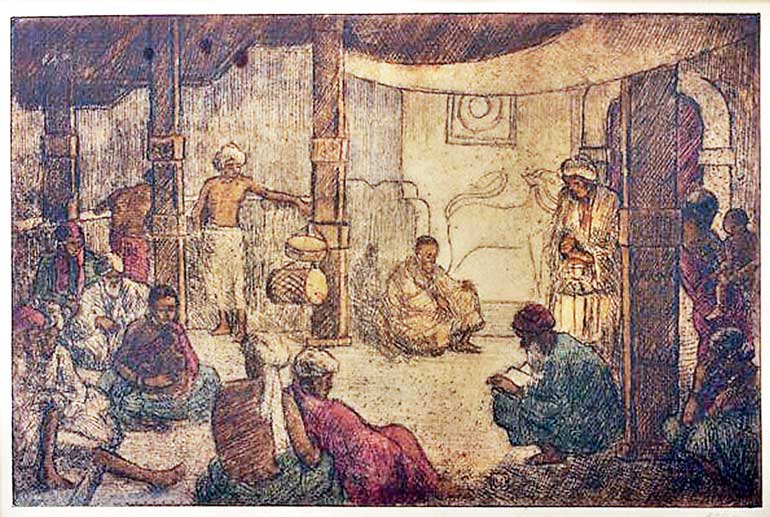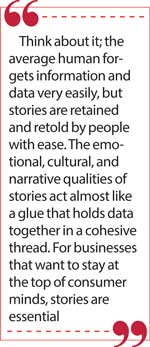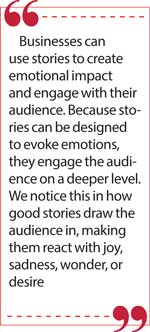Monday Apr 21, 2025
Monday Apr 21, 2025
Thursday, 25 April 2024 00:22 - - {{hitsCtrl.values.hits}}

Stories have been a primary means of transmitting knowledge and cultural values across generations. Community reading in the Temple in Sri Lanka circa 1923 from a hand etching by Charles W. Bartlett

The thirst for stories is evidenced in how people attended book fairs through the pandemic and economic restrictions. So much so, that we wonder whether our collective appetite for stories is only heightened in crises. Photo by B.Ganguly.
 To consumers jaded with advertising and promotions being bombarded at them, brands that tell authentic and meaningful stories are a welcome experience. Humans are inherently drawn to stories and they even shape our thinking and behavior. Research identifies stories as one of the most effective ways to communicate and retain information with cultural and emotional relevance. This means greater room for businesses to connect and form meaningful interactions by cutting through the information clutter. Good stories help make brands more memorable and consumers more interested in engaging with a business’s products or services. This is a closer look at why stories are more effective forms of communication and why businesses benefit from their potent ability to engage the human mind and form deeper connections with consumers.
To consumers jaded with advertising and promotions being bombarded at them, brands that tell authentic and meaningful stories are a welcome experience. Humans are inherently drawn to stories and they even shape our thinking and behavior. Research identifies stories as one of the most effective ways to communicate and retain information with cultural and emotional relevance. This means greater room for businesses to connect and form meaningful interactions by cutting through the information clutter. Good stories help make brands more memorable and consumers more interested in engaging with a business’s products or services. This is a closer look at why stories are more effective forms of communication and why businesses benefit from their potent ability to engage the human mind and form deeper connections with consumers.
Stories differ from raw data due to their emotivity, narrative quality, and ability to relate to humans. Stories give context to data; storytelling is the act of humanizing data with emotions, culture, and values. Whether as videos, books, corporate reports, articles, or social media content, good stories connect a business with its audience through emotions, cultural relevance, and empathising with their needs, values, and ideas.
Think about it; the average human forgets information and data very easily, but stories are retained and retold by people with ease. The emotional, cultural, and narrative qualities of stories act almost like a glue that holds data together in a cohesive thread. For businesses that want to stay at the top of consumer minds, stories are essential.
 Almost a decade ago, Paul Zak, a neuroscientist, published research on how oxytocin, the ‘love hormone’, is released through the experience of good stories, enhancing trust and empathy. Narrative Transportation Theory, by Melanie Green and Timothy Brock, explores how engaging narratives can ’transport’ individuals into the story world, leading to greater cognitive and emotional involvement, and explains why people remember stories easily. These are just a few examples of the extensive research conducted on stories as a powerful form of communication that can influence the human brain, emotions, and decision-making processes.
Almost a decade ago, Paul Zak, a neuroscientist, published research on how oxytocin, the ‘love hormone’, is released through the experience of good stories, enhancing trust and empathy. Narrative Transportation Theory, by Melanie Green and Timothy Brock, explores how engaging narratives can ’transport’ individuals into the story world, leading to greater cognitive and emotional involvement, and explains why people remember stories easily. These are just a few examples of the extensive research conducted on stories as a powerful form of communication that can influence the human brain, emotions, and decision-making processes.
Businesses can use stories to create emotional impact and engage with their audience. Because stories can be designed to evoke emotions, they engage the audience on a deeper level. We notice this in how good stories draw the audience in, making them react with joy, sadness, wonder, or desire.
Memorability is another great reason why businesses can use stories. Stories are memorable because they create vivid mental images and people tend to remember stories and the lessons or messages within them. Neuroscience research suggests that stories activate various parts of the brain, including areas responsible for language processing, sensory experiences, and emotions. This multisensory engagement makes the information more memorable.
 By using stories, businesses can communicate indirectly by conveying a message through a narrative. This often prompts the audience to draw conclusions or extract lessons from the story. Stories are also highly potent connectors because they can be designed to entertain, inspire, persuade, or educate by providing context and emotional resonance to a message or idea.
By using stories, businesses can communicate indirectly by conveying a message through a narrative. This often prompts the audience to draw conclusions or extract lessons from the story. Stories are also highly potent connectors because they can be designed to entertain, inspire, persuade, or educate by providing context and emotional resonance to a message or idea.
Stories have been a primary means of transmitting knowledge and cultural values across generations. They facilitate social learning by conveying information in a format that is easy to remember and share. This is why certain stories become deeply ingrained in a culture›s collective memory. These cultural narratives are passed down through generations and play a significant role in shaping cultural identity. For businesses, tapping into cultural relevance is one of the most powerful aspects of using stories. By incorporating familiar themes, values, and symbols relevant to target audiences, businesses can resonate with entire communities. This relatability allows customers to see themselves in the story, making it easier for them to relate to the product or service being offered. Stories that resonate with the culture and values of the target audience are more likely to be well-received. Businesses that understand their customers› cultural context can tailor their stories accordingly.
 To get people looking forward to hearing your stories, make sure your business doesn’t become that person who only sends ‘Good morning’ forwards on WhatsApp; offer something valuable, whether it’s insight, news, amusement, beauty, or entertainment.
To get people looking forward to hearing your stories, make sure your business doesn’t become that person who only sends ‘Good morning’ forwards on WhatsApp; offer something valuable, whether it’s insight, news, amusement, beauty, or entertainment.
Overall, stories are powerful tools for communication and information retention due to their ability to engage multiple cognitive and emotional processes while maintaining cultural relevance. In a crowded marketplace, storytelling can set a business apart from its competitors. A well-crafted narrative can highlight the unique qualities of a product or service.
When you repeatedly, reliably reward your audience with stories that are worth their while, they will stop scrolling past your posts, spend more time on your website, and actually open your newsletter. Stories are among the best ways for a business to connect with its audience.
(The author is a story designer based in Colombo, Sri Lanka. With over fifteen years in commercial writing, Shamalee specialises in designing stories that connect brands with their audiences. She co-created Public Works—the Colombo-based story design studio—with her partner Alain Parizeau.)